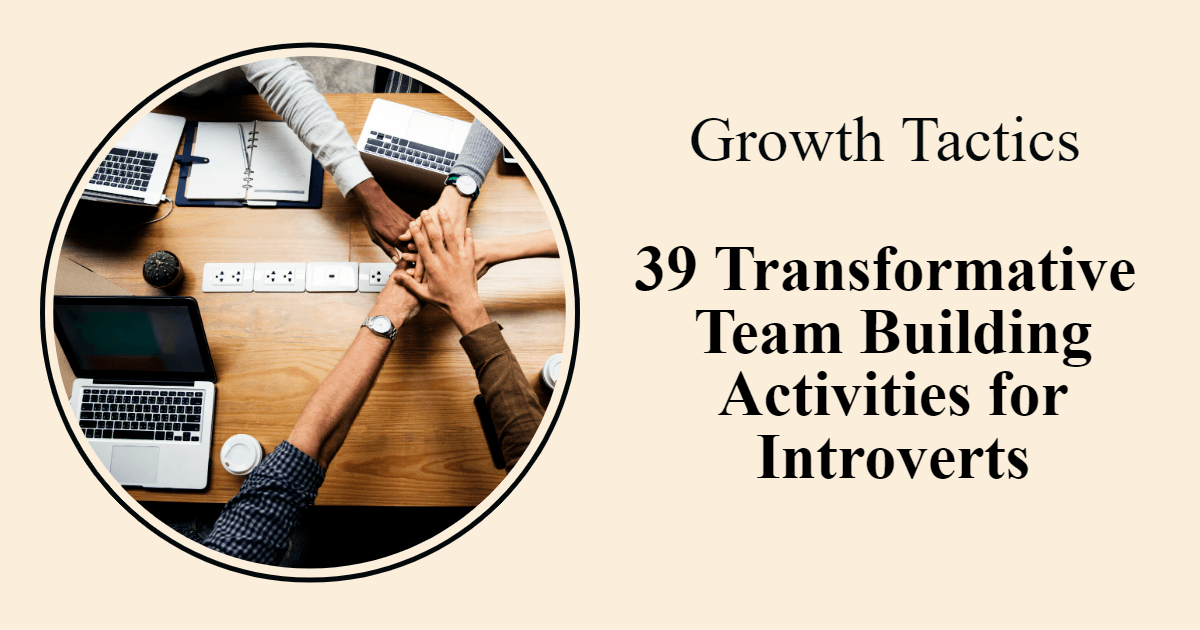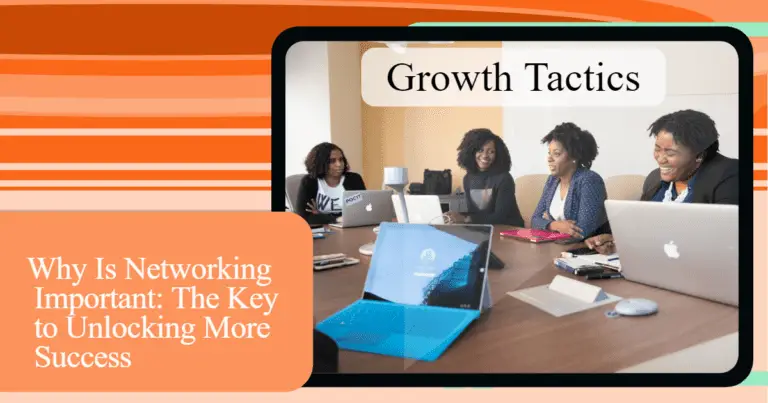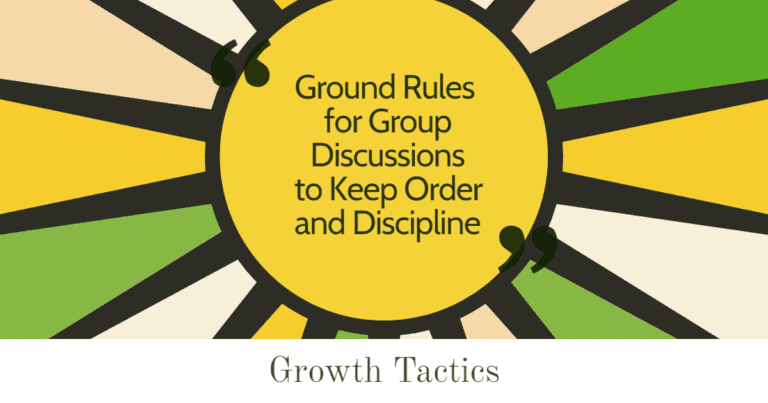Introverts bring a unique set of strengths to any team. However, traditional team-building activities often overlook the needs of introverted individuals. Today, we’ll explore 39 powerful activities designed to help introverts shine. Each activity fosters leadership, personal growth, and problem-solving while respecting individuality. Let’s get started!
Jump To Section
Understanding Introversion
Introverts tend to be more reserved and gain energy from solitude rather than social interactions. Recognizing and valuing these traits is the first step in creating an inclusive team environment. Remember, leadership isn’t about fitting everyone into the same mold. It’s about celebrating diverse strengths and fostering a culture where everyone can excel.
Principles for Effective Team Building with Introverts
Leading a team of diverse individuals, including introverts, requires a nuanced approach. Introverts bring depth, thoughtfulness, and a reflective nature to the table, which can be invaluable in any team setting. To engage introverts meaningfully, adhere to these key principles:
Respect Individual Space: Allow Time for Independent Thought
Introverts thrive in environments where they can process and reflect in solitude. This doesn’t mean they are disengaged or uninterested; rather, they perform best when given the space to think deeply and prepare. As a leader, facilitate periods of independent work or quiet reflection within team projects to make people feel more comfortable. Provide opportunities for team members to contemplate solutions independently before presenting ideas in group settings. This small adjustment can result in profound contributions from those who need a bit of solitude to shine.
Focus on Small Groups: Smaller Interactions Are Often More Comfortable
Smaller group interactions tend to be less overwhelming for introverts, allowing them to engage more fully and authentically. Large, boisterous team-building exercises might be counterproductive for these individuals. Instead, prioritize activities that involve smaller, more intimate groups. This could mean breaking a large team into smaller cohorts for discussions, projects, or problem-solving activities. When you focus on smaller groups, you create a comfortable environment where introverts can confidently share their insights and ideas, driving meaningful contributions and enhancing team dynamics.
Meaningful Activities: Ensure Activities Have a Clear Purpose
Purpose-driven activities resonate strongly with introverts who value depth and intention. Team-building exercises must go beyond superficial games and focus on activities that contribute to personal and professional growth. Whether it’s a strategic brainstorming session, skill-building workshop, or a project with tangible outcomes, make sure each activity has a clear, valuable purpose. Explain the objectives and benefits beforehand to provide context and relevance, which will engage introverts more effectively and demonstrate that every action taken is meaningful to the team’s overarching goals.
Structured Tasks: Provide Clear Guidelines and Expectations
Ambiguity can be a source of stress for many, especially introverts who may prefer clearly defined tasks and expectations. Avoid leaving activities open-ended; instead, offer structured and detailed instructions. Clearly outline the goals, steps, and desired outcomes for each task. When everyone knows exactly what is expected of them, introverts can focus their energy on delivering quality contributions without the distraction of uncertainty. Furthermore, providing structure helps introverted team members manage their time and efforts more efficiently, leading to better engagement and performance.
Be Approachable: Foster Open Lines of Communication
Leadership isn’t just about directing; it’s about listening and being approachable. Create an environment where introverted team members feel safe to voice their thoughts and concerns. Encourage open communication through one-on-one meetings or anonymous feedback channels. This approach not only boosts morale but also ensures that valuable perspectives aren’t lost. By actively listening and showing genuine interest in your team’s input, you foster a culture of trust and respect.
30 Transformative Team Building Activities
Building an effective team requires purposeful action and respect for individual approaches. Here are 35 transformative activities to help you achieve just that.
Reflection and Personal Growth Activities
In the journey towards effective leadership and meaningful team dynamics, it’s imperative we engage in activities that promote reflection and personal growth. These activities are designed not just to enhance individual capabilities but to fortify the collective strength of the team. Below are five key strategies to implement:
- Journaling SessionsActivity Description: Encourage team members to express their thoughts and insights privately through writing sessions. Implementation Steps:
- Guided Prompts: Provide thought-provoking prompts focusing on both professional achievements and personal reflections.
- Scheduled Time: Dedicate specific periods during the week for uninterrupted journaling.
- Optional Sharing: Create opportunities for those who feel comfortable to share their insights in a safe and supportive environment, fostering a sense of community.
- Cultivates self-awareness and promotes emotional intelligence.
- Offers a personal space for processing experiences and thoughts.
- Enhances clarity and purpose, which can translate into better decision-making.
- Individual Goal SettingActivity Description: Assist employees in setting personal development goals and review them in one-on-one settings. Implementation Steps:
- SMART Framework: Guide team members to create Specific, Measurable, Achievable, Relevant, and Time-bound goals.
- Regular Check-Ins: Schedule consistent one-on-one meetings to track progress, discuss obstacles, and adjust goals as necessary.
- Resource Support: Ensure access to necessary resources, such as training programs or mentorship, to facilitate goal achievement.
- Increases personal accountability and motivation.
- Provides clear direction and purpose in both personal and professional realms.
- Strengthens the support system within the team.
- Mindfulness ExercisesActivity Description: Introduce mindfulness practices such as meditation or focused breathing to enhance mental clarity and relaxation. Implementation Steps:
- Daily Routine: Begin or conclude each day with a short mindfulness exercise.
- Expert Workshops: Organize sessions led by mindfulness experts to teach effective techniques.
- Quiet Spaces: Designate areas where team members can engage in mindfulness practices during breaks.
- Reduces stress and increases mental resilience.
- Improves focus and overall cognitive function.
- Creates a calm and more cohesive working environment.
- Self-Assessment ToolsActivity Description: Utilize personality or strengths assessments to help team members better understand themselves and their colleagues. Implementation Steps:
- Assessment Selection: Choose respected tools such as MBTI, DISC, or CliftonStrengths.
- Integration: Use assessment results to inform individual development plans and team-building activities.
- Feedback Loop: Encourage open discussions about assessment results to enhance mutual understanding and collaboration.
- Promotes self-discovery and uses individual strengths effectively.
- Enhances team dynamics by recognizing and valuing diverse traits.
- Facilitates better communication and collaboration.
- Mentorship PairingsActivity Description: Establish mentoring relationships to support both personal and professional growth. Implementation Steps:
- Matching Process: Pair less experienced team members with seasoned professionals based on complementary skills and goals.
- Structured Program: Develop clear guidelines and expectations for the mentorship relationship.
- Regular Interaction: Ensure consistent and meaningful engagement between mentors and mentees.
- Accelerates learning and professional development.
- Builds strong interpersonal connections and trust within the team.
- Provides a robust support system for navigating career challenges.
Collaborative but Low-Pressure Activities
Incorporating collaborative yet low-pressure activities into your team’s routine can foster a supportive environment that encourages creativity, open communication, and personal growth without the weight of high stakes. Below are expanded descriptions of five powerful activities that bridge individual strengths with collective purpose.
- Book Club DiscussionsActivity Description: Facilitate small group discussions around selected books or articles that resonate with your team’s professional and personal interests. Implementation Steps:
- Selection Process: Curate a list of books or articles, ensuring a diverse range that covers various aspects of leadership, personal development, and industry-specific knowledge.
- Discussion Groups: Form small, diverse groups that meet regularly to discuss their reflections and insights.
- Guided Questions: Provide discussion questions to foster deeper analysis and connection to real-life applications.
- Stimulates critical thinking and broadens perspectives.
- Encourages intellectual camaraderie and shared learning experiences.
- Reinforces the value of continuous personal and professional development.
- Small Group ProjectsActivity Description: Assign tasks that require collaboration in pairs or small groups, ensuring the tasks are meaningful and align with the team’s objectives. Implementation Steps:
- Project Scope: Define clear, achievable goals that require teamwork and leverage individual strengths.
- Group Formation: Carefully pair individuals based on complementary skills and mutual interests.
- Resource Provision: Supply necessary tools and resources, and set milestones for progress checks.
- Enhances problem-solving skills and team cohesion.
- Promotes a sense of shared responsibility and accomplishment.
- Provides a safe environment for exploring new ideas and methods.
- Silent BrainstormingActivity Description: Use written brainstorming before verbal sharing to allow introverts time to formulate their ideas and ensure all voices are heard. Implementation Steps:
- Setup: Provide a quiet, comfortable space with essential materials for writing or digital input.
- Guidelines: Clearly outline the topic or problem and allow ample time for individual reflection and note-taking.
- Sharing Process: Collect written ideas and discuss them collectively, ensuring each idea is respectfully considered.
- Levels the playing field by giving introverts and extroverts equal opportunity to contribute.
- Generates a diverse array of ideas and solutions.
- Reduces groupthink and encourages independent thought.
- Peer Feedback SessionsActivity Description: Create a safe space for offering and receiving constructive feedback, fostering a culture of continuous improvement and mutual support. Implementation Steps:
- Training: Educate team members on effective feedback techniques, emphasizing positive reinforcement and constructive criticism.
- Structured Sessions: Schedule regular intervals for feedback, ensuring consistency and routine.
- Confidentiality: Maintain a respectful and confidential environment to ensure honest and actionable feedback.
- Enhances personal and professional growth through targeted feedback.
- Builds trust and transparency within the team.
- Encourages self-reflection and adaptive learning.
- Collaborative Workshops
Activity Description: Host workshops on relevant topics to encourage teamwork and skill development without the pressure of formal evaluation.
Implementation Steps:
- Topic Selection: Choose topics that are pertinent to the team’s objectives and current challenges, ensuring they offer practical value.
- Expert Involvement: Invite knowledgeable speakers or facilitators to lead the sessions, combining theoretical knowledge with hands-on practice.
- Interactive Elements: Include group activities, discussions, and problem-solving exercises to engage participants fully.
Benefits:
- Boosts collective skills and knowledge in a relaxed environment.
- Strengthens teamwork and collaborative problem-solving.
- Provides a platform for continuous learning and adaptation.
Creative and Expressive Activities
Fostering a creative environment within your team is not merely about fun and relaxation. It’s about unlocking new perspectives, enhancing problem-solving abilities, and nurturing individual expression and growth. Below are expanded descriptions of five activities designed to cultivate creativity and self-expression, while reinforcing the importance of individuality and purpose-driven action.
- Artistic Expression Workshops
Activity Description: Host sessions for drawing, painting, or crafting that encourage team members to unleash their creativity and explore new mediums of expression.
Implementation Steps:
- Preparation: Gather necessary materials for various art forms, such as canvases, paints, brushes, and craft supplies.
- Facilitation: Hire a skilled facilitator or artist to guide the sessions, ensuring that participants feel supported in their creative endeavors.
- Environment: Create a relaxing, judgment-free zone where team members feel comfortable experimenting with their artistic skills.
Benefits:
- Enhances creativity and innovative thinking.
- Provides a therapeutic outlet for stress and fosters mental well-being.
- Encourages individuals to step outside their comfort zones and discover new talents.
- Storytelling Circles
Activity Description: Create spaces where team members can share personal stories within a supportive and empathetic environment.
Implementation Steps:
- Circle Formation: Arrange seating in a circle to promote equality and openness.
- Themes: Pick themes that resonate with the team’s experiences and values, such as leadership lessons, personal challenges, or memorable achievements.
- Guidance: Provide storytelling tips and create a set of ground rules to ensure respect and confidentiality.
Benefits:
- Builds stronger interpersonal connections and understanding.
- Promotes vulnerability and trust within the team.
- Enhances listening skills and empathy.
- Music Appreciation Sessions
Activity Description: Share and discuss favorite music or playlists to build connections through shared interests and experiences.
Implementation Steps:
- Playlist Creation: Invite team members to create and share playlists that reflect their tastes and moods.
- Discussion Forums: Organize casual listening sessions where individuals can discuss why specific pieces of music are meaningful to them.
- Live Music: If possible, incorporate live music performances to add an experiential layer.
Benefits:
- Strengthens bonds through shared cultural experiences.
- Provides a fun and informal way to connect on a personal level.
- Encourages cultural exchange and broadens musical horizons.
- Creative Writing Exercises
Activity Description: Encourage team members to write and share short stories, essays, or poetry as a means of creative self-expression.
Implementation Steps:
- Writing Prompts: Provide thought-provoking prompts that inspire reflection and creativity.
- Sharing Sessions: Create a platform for individuals to share their work and receive supportive feedback.
- Publication: Consider compiling the works into a team anthology as a memento and team-building artifact.
Benefits:
- Enhances communication skills and self-expression.
- Provides a contemplative space for personal growth and reflection.
- Fosters a sense of accomplishment and pride in one’s creative abilities.
- Photography Challenges
Activity Description: Organize themed photo challenges to harness creativity and self-expression through the lens of a camera.
Implementation Steps:
- Thematic Focus: Select diverse themes that challenge team members to view their surroundings in new and creative ways, such as “Gratitude,” “Leadership in Everyday Life,” or “Unseen Beauty.”
- Exhibitions: Hold exhibitions where participants can showcase their work and discuss their creative process.
- Feedback: Create avenues for constructive feedback and appreciation, perhaps even incorporating a light-hearted competition element.
Benefits:
- Encourages mindfulness and attention to detail.
- Provides a powerful medium for personal expression and storytelling.
- Fosters a shared sense of creativity and community.
Strategy and Problem-Solving Activities
When it comes to strategy and problem-solving, having a purpose-driven approach is essential. These activities are designed to enhance critical thinking, teamwork, and innovation—skills that are indispensable in both military leadership and civilian life. By focusing on individuality and collaboration, we can foster a culture of capable, strategic thinkers who are prepared for any challenge that comes their way.
- Puzzle ChallengesActivity Description: Engage in activities that involve solving complex puzzles or participating in escape room scenarios to stimulate critical thinking. Implementation Steps:
- Selection: Choose puzzles or escape room themes that align with your team’s skills and interests, ensuring a good mix of difficulty and enjoyment.
- Team Formation: Divide participants into small teams to foster collaboration and diverse problem-solving approaches.
- Debriefing: After the challenge, hold a debriefing session to discuss the strategies used and lessons learned.
- Enhances problem-solving and critical thinking skills.
- Encourages teamwork and effective communication under pressure.
- Provides a fun and engaging way to improve team dynamics.
- Strategy GamesActivity Description: Introduce board games that require planning and teamwork, such as Settlers of Catan, Risk, or Pandemic. Implementation Steps:
- Game Selection: Choose games that are not only entertaining but also require strategic planning and cooperation.
- Facilitation: Ensure that rules are clearly explained and that a facilitator is available to guide the gameplay.
- Reflection: Conclude the game with a reflection session to analyze decision-making processes and strategic planning.
- Develops strategic thinking and foresight.
- Strengthens teamwork and collaborative problem-solving.
- Provides a low-stakes environment to practice complex decision-making.
- Scenario PlanningActivity Description: Work through hypothetical scenarios relevant to your industry to promote strategic thinking and preparedness. Implementation Steps:
- Scenario Development: Create realistic and challenging scenarios that your team might face in your specific industry.
- Group Discussion: Divide the team into groups to brainstorm and develop response strategies.
- Presentation: Have each group present their strategies and receive feedback.
- Enhances strategic planning and adaptability.
- Prepares teams for real-world challenges by simulating potential situations.
- Encourages diverse perspectives and innovative solutions.
- Innovation LabsActivity Description: Host sessions focused on developing new ideas or solutions to existing problems within a structured, creative environment. Implementation Steps:
- Topic Selection: Identify current challenges or areas for innovation within your organization.
- Facilitation: Provide skilled facilitators to guide brainstorming and creative problem-solving processes.
- Prototyping: Encourage rapid prototyping and iteration of ideas, with ongoing feedback and refinement.
- Fosters a culture of innovation and continuous improvement.
- Encourages out-of-the-box thinking and creativity.
- Provides a platform for individuals to contribute unique ideas and solutions.
- Problem-Solving WorkshopsActivity Description: Tackle real team challenges in a structured, collaborative environment to develop effective, long-term solutions. Implementation Steps:
- Problem Identification: Identify specific, pressing challenges facing your team.
- Structured Approach: Use established problem-solving frameworks such as root cause analysis, SWOT analysis, or Six Sigma.
- Collaborative Effort: Encourage all team members to contribute their insights and expertise.
- Provides practical solutions to real-world problems.
- Strengthens problem-solving and analytical skills.
- Fosters a collaborative, team-oriented approach to overcoming challenges.
Individual and Thoughtful Activities
In our pursuit of leadership and personal growth, it’s crucial to understand the power of individual reflection and thoughtful action. The following activities are designed to foster a deeper connection with oneself and one’s purpose. Whether inspired by the disciplined approach of military training or the introspective moments that shape great leaders, these activities emphasize the importance of individuality and intentional action.
- Nature WalksActivity Description: Take team members on quiet, mindful walks in nature to promote reflection and rejuvenation. Implementation Steps:
- Location Selection: Choose a serene location, such as a park, forest, or nature reserve, that is easily accessible.
- Guided Walks: Offer the option of guided walks with focused themes, such as mindfulness, meditation, or leadership reflections.
- Silent Reflection: Encourage periods of silence during the walk to allow for personal introspection.
- Reduces stress and enhances mental clarity.
- Provides a natural setting for personal reflection and rejuvenation.
- Strengthens emotional well-being and connection to the environment.
- Solo ProjectsActivity Description: Allow individuals to take on meaningful projects independently, providing a sense of ownership and purpose. Implementation Steps:
- Project Selection: Identify projects that align with organizational goals and individual strengths or interests.
- Autonomy and Support: Empower individuals with the autonomy to approach the project in their own way, while offering support and resources as needed.
- Progress Check-Ins: Schedule regular check-ins to provide guidance, feedback, and encouragement.
- Encourages independent problem-solving and creativity.
- Builds confidence and a sense of accomplishment.
- Allows individuals to demonstrate and expand their capabilities.
- Skill-Sharing SessionsActivity Description: Encourage team members to share skills or hobbies they’re passionate about in a low-pressure setting, fostering a collaborative and learning-focused environment. Implementation Steps:
- Identify Skills: Have team members volunteer to share skills or hobbies they are passionate about.
- Schedule Sessions: Organize regular sessions where individuals can present and teach their skills to the team.
- Inclusive Environment: Ensure the setting is informal and supportive, encouraging participation and questions.
- Promotes knowledge sharing and skill diversification.
- Enhances team bonding and appreciation of individual talents.
- Provides opportunities for personal growth and learning.
- Personal Reflection TimeActivity Description: Allocate time in the workday specifically for personal reflection and growth, emphasizing the importance of introspection. Implementation Steps:
- Scheduling: Designate specific times during the workday for personal reflection, such as early morning or after lunch.
- Quiet Spaces: Provide quiet, comfortable spaces for individuals to reflect without interruptions.
- Reflection Prompts: Offer prompts or journaling exercises to guide reflection if desired.
- Improves self-awareness and emotional intelligence.
- Fosters a culture of mindful and intentional action.
- Provides space for personal and professional growth.
- Reading TimeActivity Description: Provide designated time for team members to read industry-related books, articles, or other relevant materials to stay informed and inspired. Implementation Steps:
- Curated Reading List: Compile a list of recommended readings that align with industry trends and personal development goals.
- Reading Schedule: Set aside regular, dedicated time for reading during the workday.
- Discussion Groups: Encourage the formation of book clubs or discussion groups to share insights and perspectives.
- Keeps team members informed about industry developments and best practices.
- Stimulates intellectual growth and continuous learning.
- Encourages the exchange of ideas and collaborative learning.
Technology-Based Activities
Embracing technology is a powerful way to drive personal growth and enhance team collaboration. As leaders, it’s our duty to create an environment where every individual can thrive, find their unique solutions, and work towards a purpose-driven goal. The following technology-based activities are designed to not only elevate the team’s efficiency but also to respect and nurture individual approaches. Drawing from military precision and leadership, here’s a pragmatic guide to integrate technology seamlessly into your team’s workflow.
- Virtual HangoutsActivity Description: Use online platforms to enable introverted team members to engage at their own pace, ensuring everyone has a voice. Implementation Steps:
- Platform Selection: Choose user-friendly video conferencing tools such as Zoom, Microsoft Teams, or Google Meet.
- Engagement Options: Offer various ways to participate, like chat functions, breakout rooms, and anonymous question submissions.
- Regular Scheduling: Set up regular virtual hangouts to keep connections strong and provide consistent opportunities for engagement.
- Creates a safe space for all team members, especially introverts, to share their thoughts.
- Builds strong, inclusive team dynamics.
- Fosters continuous communication and reduces isolation in remote settings.
- Digital Brainstorming ToolsActivity Description: Implement tools such as digital whiteboards for inclusive brainstorming sessions that capture everyone’s ideas. Implementation Steps:
- Tool Selection: Use platforms like Miro, MURAL, or Google Jamboard that support collaborative brainstorming.
- Inclusive Sessions: Facilitate brainstorming sessions where team members can contribute in real-time or asynchronously.
- Idea Sharing: Encourage diverse input by providing specific prompts and allocating time for everyone to share their ideas.
- Ensures all voices are heard, leading to richer and more innovative solutions.
- Promotes a culture of creativity and openness.
- Enhances collaboration and team problem-solving skills.
- Online CoursesActivity Description: Offer access to online learning tailored to individual interests and developmental needs, fostering continuous professional growth. Implementation Steps:
- Course Selection: Provide a range of courses from platforms such as Coursera, LinkedIn Learning, and Udemy.
- Personal Development Plans: Work with team members to identify their interests and professional goals to select relevant courses.
- Flexible Learning: Allow flexibility in completing courses to fit individual schedules and learning styles.
- Empowers team members to take charge of their personal and professional development.
- Ensures the team stays updated with the latest skills and knowledge.
- Enhances job satisfaction and retention through personalized growth opportunities.
- Virtual Reality ExperiencesActivity Description: Utilize VR for immersive team-building exercises, creating experiences that strengthen team bonds and facilitate deeper understanding. Implementation Steps:
- VR Equipment: Invest in VR headsets and software tailored to corporate team-building activities.
- Experience Selection: Choose VR experiences that align with team-building goals, such as virtual escape rooms or collaborative problem-solving games.
- Debrief Sessions: Conduct debrief sessions post-VR activity to discuss experiences, insights, and applications to the workplace.
- Provides a unique and engaging way to build team cohesion.
- Enhances problem-solving and communication skills in a novel setting.
- Fosters camaraderie and a shared sense of achievement.
- Remote Collaboration ToolsActivity Description: Equip your team with tools for efficient and stress-free remote work, enhancing productivity and reducing operational bottlenecks. Implementation Steps:
- Tool Selection: Implement tools such as Slack for communication, Trello for project management, and Google Workspace for document collaboration.
- Training: Provide training sessions to ensure all team members are comfortable and proficient with the tools.
- Best Practices: Establish best practices and protocols for using these tools effectively, emphasizing clear communication and regular updates.
- Increases productivity by streamlining workflows and communication.
- Reduces stress by providing clear structures and easy access to necessary resources.
- Supports a flexible and adaptable working environment, accommodating various working styles and preferences.
9 Icebreakers for Introverts: Bridging Connections with Purpose
Harness the power of team synergy by implementing icebreakers that respect and integrate the unique strengths of our introverted team members. These activities are designed to foster genuine connections and cultivate a conducive environment for personal growth and leadership development.
1. Two-Truths and a Lie
Start with the classic game, Two-Truths and a Lie. This exercise helps team members learn intriguing facts about each other in a simple manner. Each person shares two true statements and one false one, while the team guesses which statement is the lie. This breaks the ice gently and encourages light-hearted interaction.
2. Common Interests Map
Next, utilize a whiteboard or a virtual board to map out common interests within the team. Known as the Common Interests Map, each member writes down their hobbies, favorite books, or movies. Connecting over shared interests provides a solid foundation for deeper conversations and trust.
3. Silent Introductions
Another approach is Silent Introductions. Partner up team members and allow them to introduce each other through drawing or writing rather than speaking. This method eases the pressure of verbal communication and still accomplishes the goal of getting to know each other.
4. Story Cubes
Consider using Story Cubes to prompt creative storytelling. Each cube has different images, and team members use them to create a collaborative story. This activity sparks creativity and ensures everyone contributes without feeling the spotlight’s pressure.
5. Personal Mantras
Ask each team member to share a personal mantra or quote that inspires them. Discussing these mantras can provide insight into each other’s values and motivations, laying the groundwork for mutual respect and understanding.
6. Question Ball
Introduce the Question Ball. Write various open-ended questions on a beach ball. Toss the ball around, and when someone catches it, they answer the question facing them. This spontaneous method brings a mix of fun and introspection.
7. Show and Tell
Encourage team members to bring an item from home that is meaningful to them for a Show and Tell session. Sharing these stories fosters a deeper connection and provides context to each member’s personal background and passions.
8. Introvert Spotlight
Implement the Introvert Spotlight. Rotate a “spotlight” among team members where they have the floor to share anything they feel comfortable with—be it a project update, a personal achievement, or a passion. This ensures everyone has a voice without the pressure of impromptu speaking.
9. Rotating Leadership Roles
Introduce tasks or small project leadership roles that rotate each week. Rotating Leadership Roles not only breaks the ice but also helps develop leadership skills in a non-threatening environment. Each member gets the chance to lead with the support of their team.
Implementing Team Building Activities
Integrating these activities into your regular routine requires thoughtfulness. Solicit feedback and be prepared to adjust based on what works best for your team. Remember, the goal is to create an environment where every member feels valued and empowered to contribute.
The Role of Leadership in Supporting Introverts
As a leader, your role is crucial. You must recognize the unique strengths of your introverted team members and provide opportunities for them to thrive. Here are some tips:
- Be Observant: Pay attention to how introverted employees engage and look for ways to support them.
- Create Safe Spaces: Establish environments where introverts feel comfortable sharing their ideas.
- Encourage Growth: Offer opportunities for personal and professional development tailored to their strengths.
Conclusion
Introverts can be transformative assets to any team when their unique needs are met. By implementing purpose-driven and inclusive team-building activities, you can help every team member thrive. Remember, leadership is about prioritizing people first, fostering personal growth, and creating a culture of respect and inclusion. Let’s harness the full potential of every individual, one meaningful activity at a time.








